
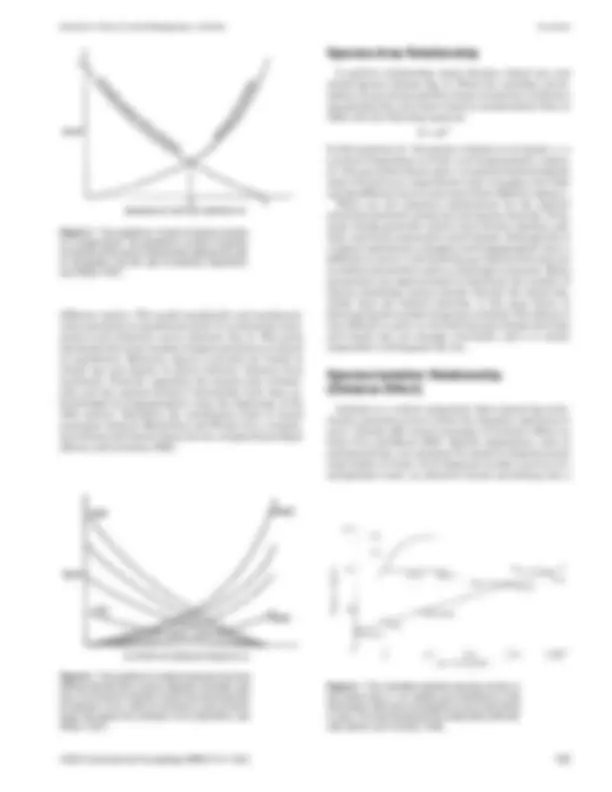
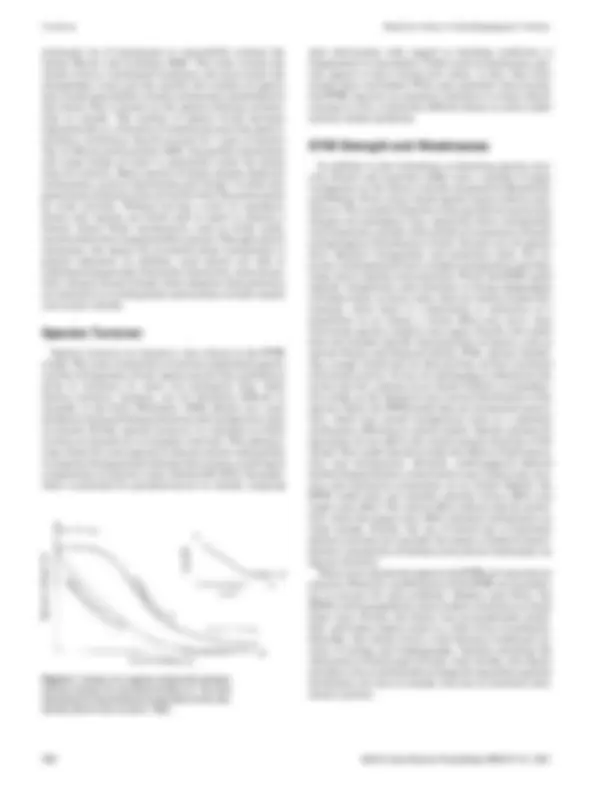
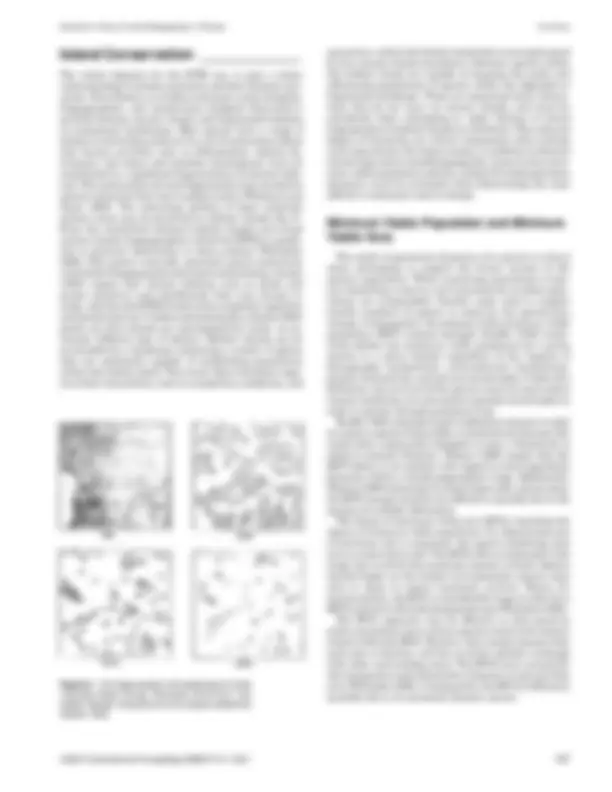
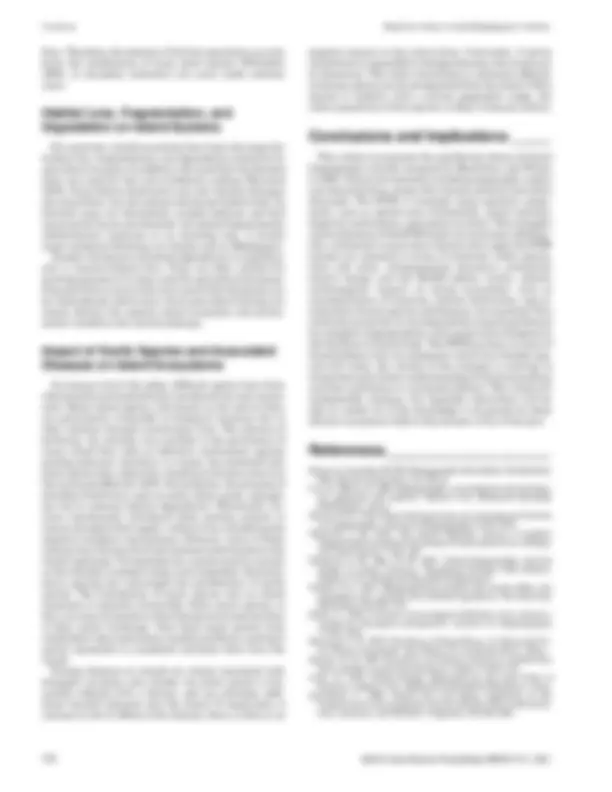
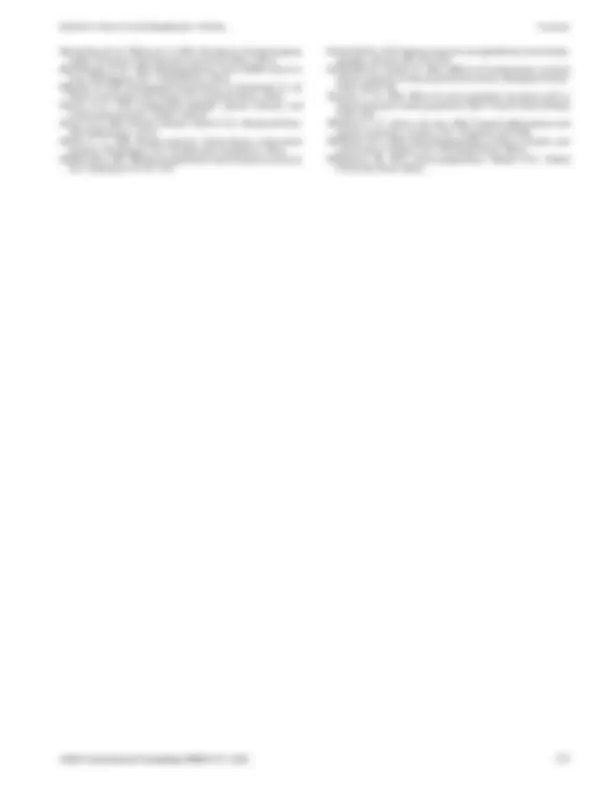


Study with the several resources on Docsity

Earn points by helping other students or get them with a premium plan


Prepare for your exams
Study with the several resources on Docsity

Earn points to download
Earn points by helping other students or get them with a premium plan
Community
Ask the community for help and clear up your study doubts
Discover the best universities in your country according to Docsity users
Free resources
Download our free guides on studying techniques, anxiety management strategies, and thesis advice from Docsity tutors
An overview of island biogeography, focusing on the topography, climate, and species distribution on islands. It discusses the equilibrium theory of island biogeography and its applications to continental reserve designs. The article also explores the impact of anthropogenic activities on island ecosystems, including overexploitation, habitat destruction, and biological invasions. various types of islands, their geological origins, and the impact of elevation on island climate.
What you will learn
Typology: Study notes
1 / 9

This page cannot be seen from the preview
Don't miss anything!






In: McArthur, E. Durant; Fairbanks, Daniel J., comps. 2001. Shrubland ecosystem genetics and biodiversity: proceedings; 2000 June 13–15; Provo, UT. Proc. RMRS-P-21. Ogden, UT: U.S. Department of Agriculture, Forest Service, Rocky Mountain Research Station. Angela D. Yu is a Graduate Student, Department of Geography, Univer- sity of Colorado at Boulder, Boulder, CO 80309-0030. Simon A. Lei is a Biology and Ecology Professor at the Community College of Southern Nevada, 6375 West Charleston Boulevard, WDB, Las Vegas, NV 89146-
Abstract —The topography, climatic pattern, location, and origin of islands generate unique patterns of species distribution. The equi- librium theory of island biogeography creates a general framework in which the study of taxon distribution and broad island trends may be conducted. Critical components of the equilibrium theory include the species-area relationship, island-mainland relation- ship, dispersal mechanisms, and species turnover. Because of the theoretical similarities between islands and fragmented mainland landscapes, reserve conservation efforts have attempted to apply the theory of island biogeography to improve continental reserve designs, and to provide insight into metapopulation dynamics and the SLOSS debate. However, due to extensive negative anthropo- genic activities, overexploitation of resources, habitat destruction, as well as introduction of exotic species and associated foreign diseases (biological invasions), island conservation has recently become a pressing issue itself. The objective of this article is to analyze previously published data, and to review theories from numerous research studies that attempt to explain species patterns on islands. In effect, this analysis brings insight into current issues of continental reserve design and island conservation efforts.
The equilibrium theory of island biogeography (ETIB), proposed by MacArthur and Wilson, is a relatively recent development that has sparked a tremendous amount of scientific controversy. Initially introduced to the public in 1963 as “An Equilibrium Theory of Insular Zoogeography,” the idea was expanded in 1967 into a book publication. The ETIB implies that island fauna and flora (biota) eventually reach an equilibrium point between extinction and immigra- tion. Although species rarely reach equilibrium due to the extremely dynamic island system, MacArthur and Wilson note that the ETIB permits general predictions of future island biodiversity patterns. In this article, the theory of island biogeography is examined in reference to island environments, including topographic origins and charac- teristics, as well as climatic patterns. A comprehensive analysis of the theory is discussed, such as species-area
relationship, dispersal mechanisms and their response to isolation, and species turnover. Additionally, conservation of oceanic and continental (habitat) islands is examined in relation to minimum viable populations and areas, metapopulation dynamics, and continental reserve design. Finally, adverse anthropogenic impacts on island ecosys- tems are investigated, including overexploitation of re- sources, habitat destruction, and introduction of exotic spe- cies and diseases (biological invasions). Throughout this article, theories of many researchers are re-introduced and utilized in an analytical manner. The objective of this article is to review previously published data, and to reveal if any classical and emergent theories may be brought into the study of island biogeography and its relevance to mainland ecosystem patterns.
Island topography is primarily determined by the geo- physical origins of the island. Marine islands may be subdi- vided into two geophysically distinct categories: continental shelf islands (land-bridge islands) and oceanic islands. Con- tinental shelf islands are likely to be physically connected to the mainland during low sea level periods. Due to their connection, these islands have similar geological structure to the nearby mainland (Williamson 1981). This similar topography, coupled with the island’s close proximity to the continent, results in the proliferation of similar flora and fauna (biota). Oceanic islands are typically more isolated, and may have never been physically connected to a continental landmass. There are three main types of oceanic islands: oceanic ridge islands, hot-spot islands, and the individual islands of island arcs. Oceanic ridge islands and hot-spot islands are volcanic islands because they are formed from ocean-floor volcanoes. Islands that are part of island arcs also have a volcanic origin, involving the collision of continental and oceanic plates, resulting in islands that consist of both basalt and granite rock (Williamson 1981). All of the geological processes occurring volcanic islands can produce islands with high elevations, with peaks of at least 2,000 m (fig. 1) (Williamson 1981). Volcanic islands are typically steeper and become increasingly dissected with age. This phenomenon has important implications for island biota because a wide range of elevational gradients and associated ecological attributes allows for the persistence of diverse habitats. The elevation of islands also has impor- tant influences on the climatic regime.
Yu and Lei Equilibrium Theory of Island Biogeography: A Review
Island climate is determined by both external influences, such as ocean circulation and atmospheric circulation, and internal influences, such as island size, shape, and topogra- phy. Ocean circulation and atmospheric circulation consist of water currents and air currents, respectively, that have similar movements of upwelling and sinking. If an island is in the path of a moving current or is located where two currents intersect, this can alter the climate significantly. In addition to circulation influences, the proximity of an island to a continental landmass also affects the island’s climate. Islands located close to a mainland, such as land-bridge islands, are likely to be influenced by the continental cli- mate. Remote oceanic islands, on the contrary, are influ- enced by the maritime climate. Internal influences, such as island size and elevation, can have a substantial impact on the precipitation regime on the island. Whittaker (1998) states that low islands typically have relatively dry climates and high islands are wetter through orographic rainfall, resulting in the creation of extensive arid regions due to the rain shadow effect. These higher islands often contain diverse habitats within a rela- tively small area. Due to the impact of elevation on island climate, research studies have indicated that elevation is a critical variable in analyzing species diversity on islands. Telescoping, a compression of elevational zones, is fairly common on small tropical islands. Leuschner (1996) proposes that forest lines on islands are generally 1,000 to 2,000 m lower than forest lines on continents. Hence, telescoping
creates smaller patches from a variety of habitats favorable to many species, and permits high- and low-elevation inhab- iting species to coexist in a relatively small area (Whittaker 1998).
Island Patterns _________________
The Equilibrium Theory of Island Biogeography (ETIB) revolutionizes the way in which biogeographers and ecolo- gists viewed island ecosystems. Prior to the ETIB was the static theory of islands (Dexter 1978), which hypothesizes that island community structures remain relatively con- stant over geological time. The only mechanism for biologi- cal change was the gradual evolutionary process of specia- tion. Few successful colonization events would occur due to a limited number of ecological niches on the island (Lack 1976). Once these niches are completely filled, no space and resources are available for new immigrants, and they may not become successfully established on the island. The ETIB refutes the static theory, indicating that island communities exhibit a dynamic equilibrium between species colonization and extinction, or species turnover. The immigration curve is descending and is shaped concavely because the most successful dispersing species would colonize initially, fol- lowed by a significant decrease in the overall rate of immi- gration (fig. 2). The extinction curve, on the contrary, is an ascending curve because as more species inhabit the island through time, more species would become extinct exponen- tially (fig. 2). Such a trend is amplified due to a combination of population size and negative biotic interactions among
Figure 1 —A map indicating all islands with a peak of 2000 m or higher. Larger islands are shaded, smaller islands are denoted by ∆ (Williamson 1981).
Yu and Lei Equilibrium Theory of Island Biogeography: A Review
stochastic set of immigrants to successfully colonize the island (Brown and Lomolino 1998). The more remote the island is from a continental landmass, the more severe the sweepstakes route and the smaller the number of species that would successfully colonize and become established on the island. This is known as the species-isolation relation- ship on islands. The number of species would decrease exponentially as a function of isolation because the species- isolation correlation should account for a pool of species (fig. 5) (Brown and Lomolino 1998). Successful colonization over large bodies of water is potentially easier for plants than for animals. Many species of plants possess dispersal mechanisms, such as “parachutes and “wings,” to allow new generations of plants to be carried far from the parent plant by wind currents. Without having a mate to reproduce, plants only require one fertile seed or spore to colonize a remote island. Other mechanisms, such as sticky seeds, permit seeds to be transplanted by animals. Through animal assistance, the chance for successful plant immigration is greatly enhanced. In addition, some plants are able to withstand long periods of seawater immersion, and success- fully colonize remote islands. Such adaptive characteristics are essential in creating plant communities on both nearby and remote islands.
Species turnover on islands is also critical to the ETIB model. The cycle of extinction of certain established species and the immigration of new species permit the equilibrium point to maintain its value over geological time. Such species turnover, however, can be extremely difficult to quantify in the field. Whittaker (1998) detects two main problems with quantifying extinction and immigration rates on islands. Firstly, species turnover is a situation in which surveys on islands are at irregular intervals. This phenom- enon allows for some species to become extinct and possibly re-migrate during periods between the surveys, resulting in a depression of turnover rates (Simberloff 1976). Secondly, there is potential for pseudoturnover on islands, implying
that information with regard to breeding conditions is fragmentary or incomplete. Under such circumstances, spe- cies appear to have turned over when, in fact, they have simply been overlooked. With such potential inaccuracies, the ETIB requires an extensive attention to census detail, causing it to be a relatively difficult theory to prove under natural island conditions.
In addition to the limitations in detecting species turn- over, Brown and Lomolino (1998) note a number of major weaknesses in the theory initially proposed by MacArthur and Wilson. First, many island species rarely achieve equi- librium. The number of species at the equilibrium point may change over geological time, especially when immigration and extinction coincide with periods of anomalous climatic and geological (disturbance) events. Second, not all species have identical immigration and extinction rates. For in- stance, birds generally have a higher immigration rate than large, heavy reptiles and mammals. Third, the ETIB model regards immigration and extinction as being independent variables when, in many cases, they are closely related. For example, when there is a depression or extinction of a population on an island, a rescue effect may occur, thus increasing species numbers once again. Fourth, the model does not consider specific characteristics of species, such as species fitness and dispersal ability. Fifth, species inhabit- ing a single island may be derived from several mainland and island sources. It may be challenging to determine the source pool for a species on an island without a comprehen- sive study on the historical and current distribution of the species. Sixth, the ETIB model does not incorporate specia- tion, which may exceed immigration rates as a potential mechanism affecting an island system. Species present by speciation do not add to the overall species diversity of the island. This model should include the effects of both specia- tion and immigration. Seventh, anthropogenic-induced habitat fragmentation or destruction may isolate once mas- sive and continuous ecosystems on an island. Eighth, the ETIB model does not consider periodic rescue effect and target area effect. The rescue effect reduces species extinc- tion, while the target area effect enhances immigration on large islands. Finally, the use of island size is extremely general and does not consider the impact of habitat hetero- geneity (complexity of habitats and natural landscapes) on species diversity. These main arguments against the ETIB are important to examine. However, modifications of the ETIB are a possibil- ity to account for such problems. Despite such flaws, the ETIB is still acceptable by some modern scientists in at least three ways. Firstly, the theory may be graphically simpli- fied, and makes logical sense to a wide array of audiences. Secondly, this theory forms a link between traditional no- tions of ecology and biogeography, thereby enriching the information of both types of study. And, thirdly, this theory provides a clear and testable strategy for population pattern predictions not only on islands, but also on localized conti- nental systems.
Figure 5 —Display of a negative relationship between species richness (S) and island isolation (I). The inset represents the log-transformed equivalent of this rela- tionship (Brown and Lomolino 1998).
Equilibrium Theory of Island Biogeography: A Review Yu and Lei
Island Conservation _____________
The initial objective for the ETIB was to gain a better understanding of island ecosystems and their dynamic pro- cesses. Nevertheless, as studies continued, many ecologists, biogeographers, and conservation biologists discovered a parallel between oceanic islands and fragmented habitats on continental landmasses. Most species have a range of habitat in which they prefer to live, yet it has become evident that human activities such as deforestation, habitat de- struction, and urban and suburban development, have all contributed to a significant fragmentation of natural habi- tats. The continuation of such fragmentation has resulted in species extinction from local to global scales (Whitmore and Sayer 1992). The remaining patches of these relatively natural areas may be perceived as habitat islands (fig. 6). From the similarities between habitat islands and actual oceanic islands, biogeographers utilize the ETIB as a guide- line to preserve biodiversity in these patches (Whittaker 1998). This notion, ironically, spawned a great controversy in the field of biogeography and conservation biology. Janzen (1983) argues that natural habitats such as parks and nature preserves vary significantly from true oceanic is- lands, and thus the ETIB would not be completely applied to continental reserves. Unlike continental parks, Janzen (1983) points out that islands are encompassed by water, an ex- tremely different type of habitat. Habitat islands can be surrounded by a landscape containing a variety of species that are potentially capable of establishing populations within the habitat patch. This event often introduces nega- tive biotic interactions, such as competition, predation, and
parasitism, within the habitat island that is not experienced by true oceanic island ecosystems. Likewise, species within the habitat island are capable of escaping the patch and influencing populations of species within the degraded or fragmented landscape. These are important biotic interac- tions that do not occur on oceanic islands, and must be considered when attempting to apply theories of island biogeography to habitat islands on continents. The scale and degree of insularity are critical components when making such comparisons. For these reasons, in addition to theories concerning oceanic island biogeography, issues such as mini- mum viable population and area, along with metapopulation dynamics must be evaluated when determining the most effective continental reserve design.
The study of population dynamics of a species is critical when attempting to support the future success of the species’ population. When evaluating populations of spe- cies inhabiting a reserve, survival pressures on these popu- lations are compounded. Smaller areas tend to support smaller numbers of species as noted by the species-area concept. Consequently, the proposal of the minimum viable population (MVP) concept emerged. Shaffer (1981) tenta- tively defines the minimum viable population for a given species in a given habitat regardless of the impacts of demographic stochasticity, environmental stochasticity, genetic stochasticity, and natural catastrophes. Under this definition, the survival of the species must not only endure normal conditions, but also endure episodic catastrophes in order to persist through geological time. Shaffer (1981) attempts to give a definitive measure in order to conserve species living within a restricted area because this would allow conservation biologists to have a framework in which to proceed. However, Thomas (1990) argues that the MVP theory is not realistic with regard to actual population dynamics within a limited geographical range. Additionally, Thomas (1990) states that in certain large-scale, remote areas, the MVP concept would be too difficult to quantify due to the paucity of available information. The theory of minimum viable area (MVA) resembles the theory of minimum viable population. If a determined area of minimum size is conserved, the species inhabiting such area is conserved as well. The MVA often corresponds to the range size in which this particular species is found. Species located higher on the trophic level generally require more area or space to ensure maximum survival. Hence, for certain species, the MVA is considerably large in order for a MVP to persist within the designated area (Whittaker 1998). The MVA approach may be effective to help preserve entire ecosystems since various species coexist and interact closely within the MVA. However, this concept assumes that each area is discrete, and has no biotic (genetic) exchange with other surrounding areas. The MVA must account for the immigration and colonization of species in and out of the area (Whittaker 1998). Consequently, the MVA is difficult to quantify due to its extremely dynamic nature.
Figure 6 —The fragmentation of forested land in Cadiz Township Green County, Wisconsin (94.93 km^2 ), into habitat “islands” during the era of European settlement (Shafer 1990).
Equilibrium Theory of Island Biogeography: A Review Yu and Lei
Figure 9 —The simplified geometric principles for nature reserve designs derived from island biogeography research (Diamond 1975; Whittaker 1998).
Figure 8 —According to the assumptions made by the ETIB, as reduction in area will cause supersaturation as immigra- tion rates decrease and extinction rates increase. This causes a “relaxation” into a lower species equilibrium point. Under extreme circumstances, “biotic collapse” may occur and the results may be an immigration rate so low that the equilibrium number is zero.
more effective than smaller reserves, shorter distances be- tween reserves are better than longer distances, circular shaped reserves are better at maintaining reserve species than elongated shaped reserves due to a reduction of edge effects, and corridors connecting large reserves would be more favorable than without corridors (fig. 9). The use of island biogeography theory has two main limitations when applying it to the continental reserve design. Firstly, the ETIB focuses on overall species richness of a habitat island by using species-area equations. The ETIB does not allow for the prediction of species with the highest probability of becoming extirpated from the remain- ing patch (Saunders and others 1991; Whitmore and Sayer 1992; Whittaker 1998; Worthen 1996). This approach then
does not permit the investigation of specific species circum- stances within the reserve, and may prove harmful if requir- ing in-depth analysis. Secondly, the ETIB model itself is flawed. Any application of this concept to the continental reserve design and conservation policy also contains such flaws (Whittaker 1998). If the use of this theory is not meticulously studied on a case-by-case basis, certain flaws are not only represented in reserve design, but also perhaps even amplified.
Human Impact on Island Ecosystems ____________________
The utilization of island biogeography theory in determin- ing the most effective reserve design has recently been an important issue in conservation. Yet, islands themselves have also been an issue in conservation biology, mainly due to detrimental human impacts in island environments. There are numerous heated debates as to what type of impact the earliest human colonizers had on island ecosys- tems. Some ecologists and biogeographers argue that most of the earliest island colonizers were respectful of the island ecosystem, and that negative impacts occurred only after secondary arrivals of colonizers conflicted with the interests of the initial inhabitants. Others argue that earliest inhab- itants of some islands devastated the environment because of their ignorance and negligence concerning island ecosys- tems. One rather undisputed fact is that as human commu- nities on islands reached the carrying capacity, humans often modified island landscapes to support the rapidly growing population. A classic example is the terracing of steep terrain on islands in order to maximize agricultural productivity (Nunn 1994). Through history and into the modern age, negative anthropogenic impacts have contin- ued and increased. Humans can easily damage pristine island environments in four ways: overexploitation and predation by humans, habitat loss, fragmentation, and deg- radation, as well as introduction of exotic species and dis- eases (biological invasions).
Many islands contain unique endemic species because the remote quality of islands allows for the speciation of flora and fauna to be considerably different from mainland taxa. A classic example of predation of island species by humans is that of the dodo bird ( Raphus cucullatus ), once populated on the island of Mauritius, located east of Madagascar in the Indian Ocean. Dodo birds were endemic and were highly adapted to island conditions. By the early 17th century, Dutch settlers began to colonize the island, hunting both dodo birds and tortoises as food sources. Dodo birds became extinct by the year 1690. Predation of species by humans not only occurred for food sources, but also for tribal (in other words, vibrantly colored bird feathers) and exportation rea- sons. Moreover, fruit bats are currently being exported from the Polynesian islands. Not only is the declining population of fruit bats an issue of conservation, but also these bats play an imperative role in pollination and seed dispersal of island
Yu and Lei Equilibrium Theory of Island Biogeography: A Review
flora. Therefore, the absence of fruit bat population can also harm the proliferation of many plant species (Whittaker 1998). A secondary extinction can occur under extreme cases.
For centuries, island ecosystems have been the target for habitat loss, fragmentation, and degradation primarily for agricultural reasons. In addition, the wood from the forested trees was used for fuel and residential cooking (Heywood 1979). Such habitat destruction not only directly damages the island flora, but also reduces the faunal biodiversity. As forested areas are diminished, suitable habitats and food resources for fauna also diminish. As habitat fragmentation (deforestation) continues at an alarming rate, it creates major ecological dilemmas on islands such as Madagascar. Another mechanism of habitat degradation or simplifica- tion is human-induced fires. Fires are often utilized for hunting purposes or to clear a plot for agricultural purposes. Frequent fires in areas with a low natural fire frequency can be tremendously destructive. Such prescribed burning can clearly destroy the present island ecosystem and perma- nently transform the island landscape.
As humans travel the globe, different species have been intentionally and inadvertently introduced into new ecosys- tems. Many island species, also known as the native biota, are particularly vulnerable to biological invasions due to their isolation through evolutionary time. The absence of herbivory, for instance, has resulted in the persistence of many island flora with no defensive mechanisms against grazing pressures. Isolation, in a sense, has protected such plant species that, otherwise, would have become extinct on the mainland (Melville 1979). Nevertheless, the presence of abundant herbivores, such as cattle, sheep, goats, and pigs, has led to extreme habitat degradation. Historically, hu- mans intentionally introduced these grazing animals to ensure abundant food supply, without even considering the negative ecological consequences. However, many of these animals have become feral and extremely detrimental to the island landscape. Overgrazing has caused massive erosion on the hillsides, leading to large-scale landslides. Similarly, heavy grazing has encouraged the proliferation of exotic species. The introduction of exotic species into an island ecosystem is typically irreversible. Some exotic species, in fact, are more successful in these foreign environments than in their native landscape. Once those exotic species have established, their populations rapidly proliferate, making it nearly impossible to completely extirpate them from the island. Foreign diseases on islands are closely associated with biological invasions onto islands. An exotic species is fre- quently infected with a disease, and can introduce addi- tional harmful diseases onto the island. If island biota is immune to the ill effects of the disease, there is little or no
negative impact on the native biota. Conversely, if native island biota is susceptible to foreign diseases, the results can be disastrous. The entire island biota is adversely affected, and many species can be extinguished from the island. If this species is endemic with a narrow geographic range, the entire population of this species is likely to become extinct.
Conclusions and Implications _____
This article re-examines the equilibrium theory of island biogeography initially proposed by MacArthur and Wilson in 1963. Island environments including topographic origins and characteristics, along with climatic patterns have been discussed. The ETIB is analyzed using essential compo- nents, such as species-area relationship, island isolation, dispersal mechanisms, and species turnover. The strengths and weaknesses of the ETIB model are evaluated. Addition- ally, continental conservation theories that apply the ETIB concept are assessed in terms of minimum viable popula- tions and areas, metapopulation dynamics, continental reserve design, and the SLOSS debate. Lastly, adverse anthropogenic impacts on island ecosystems, such as overexploitation of resources, habitat destruction, and in- troduction of exotic species and diseases, are examined. This article has primarily re-investigated the research performed by ecologists, biogeographers, and conservation biologists at the forefront of island study. The ETIB has been an issue of heated debate since its emergence nearly four decades ago, and still today, the vitality of the concepts is evolving as researchers gain better understanding of island ecosystems and their pertinence to mainland habitats. This trend will undisputedly continue, but hopefully researchers will be able to unlock all of the knowledge to be gained by these delicate ecosystems before they become relics of the past.
References _____________________
Brown, J.; Lomolino, M. 998. Biogeography (2nd edition). Sunderland, MA: Sinauer Associates, Inc. 691 p. Cox, B.; Moore, P. 1993. Biogeography: an ecological and evolution- ary approach (5th edition). Oxford, U.K.: Blackwell Scientific Publications. 244 p. Dexter, R. W. 1978. Some historical notes on Louis Agassiz’s lecture on zoogeography. Journal of Biogeography 5:207–209. Diamond, J. M. 1975. The island dilemma: lessons of modern biogeographic studies for the design of natural preserves. Biologi- cal Conservation 7:129–146. Diamond, J. M.; May, R. M. 1981. Island biogeography and the design of nature reserves. Theoretical Ecology (2nd edition). Oxford, U.K.: Blackwell Scientific Publications. Gotelli, N. J. 1991. Metapopulation models: the rescue effect, the propagule rain, and the core-satellite hypothesis. The American Naturalist 138:768–776. Haila, Y. 1990. Towards and ecological definition of an island: a northwest European perspective. Journal of Biogeography 17:561–568. Heywood, V. H. 1979. The future of island floras. In: Bramwell, D., ed. Plants and islands. San Diego, CA: Academic Press. 459 p. Janzen, D. H. 1983. No park is an island: increase in interference from outside as park size decreases. Oikos 41:402–410. Lack, D. 1976. Island biology illustrated by the land birds of Jamaica. Oxford, U.K.: Blackwell Scientific Publications. 445 p. Leuschner, C. 1996. Timber line and alpine vegetation on the tropical and warm-temperate oceanic islands of the world: eleva- tion, structure, and floristics. Vegetatio 123:193–206.